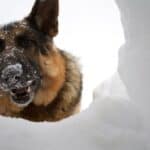Cold tolerance varies from dog to dog. Your German Shepherd should be able to handle conditions where the temperature goes below zero if you live in such a region.
Here are some tips to help you protect your beloved German Shepherd during the winter, including how cold they can handle. Check out the rest of this article to learn more.
It is common for German Shepherds to be able to tolerate temperatures down to 30°F or -1°C due to their double coats.
Even colder temperatures can be tolerated by GSDs with long hair. However, their ability to cope with cold weather may also be affected by their age, health conditions, activity level, and weight.
Other articles you would like: Basenji German Shepherd Mix Guide and Is A Malinois German Shepherd Mix Right For You?.
What Makes German Shepherds Cold-Tolerant?
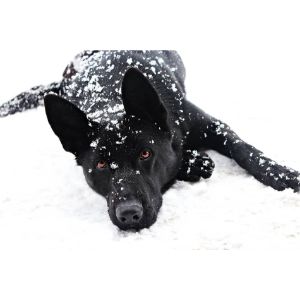
There are many things that make German Shepherd dogs more tolerant of the cold than some other breeds.
The most notable characteristic is their thick coats. Here are some other things that also help make this breed better suited for cold weather.
Double-Layered Coats
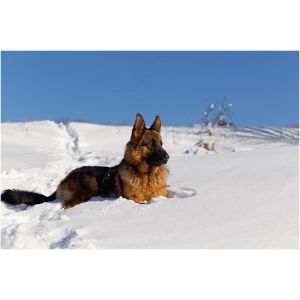
A cold climate dog breed such as a German shepherd, Siberian husky, Newfoundland, Samoyed, etc., has a double coat. In frigid temperatures, they can survive thanks to their two layers of protection – an overcoat and an undercoat.
A dense, coarse outer layer makes up the outer coat. Rain and snow won’t be able to penetrate your dog’s coat because it acts as a water-repellent barrier. On the other hand, the undercoat serves as an insulator and is plush and warm.
The length and thickness of the coats are still subject to some variation. There are many kinds of outer coats, including short, medium, and long coats with and without undercoats.
German shepherds with medium or long hair with undercoats clearly do better in cold weather than those without.
Body Size
It is estimated that German shepherds weigh between 40 and 60 pounds. In comparison to smaller dog breeds, larger dogs have a higher percentage of body fat, which makes them more insulated and protects them from the cold.
Coat Colors
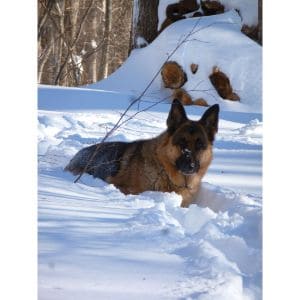
In addition to sable, black and tan, and solid black, this breed is also known for its attractive colors. In the winter, these German shepherds (albeit white and gray-colored ones) can absorb the sun’s heat rays by basking in the sunlight on clear days.
Age and Health
Healthy German shepherds in their prime are able to regulate their body temperature better than young, old, and sick German shepherds. In order to cope with the cold temperatures, they need even more assistance.
Temperatures
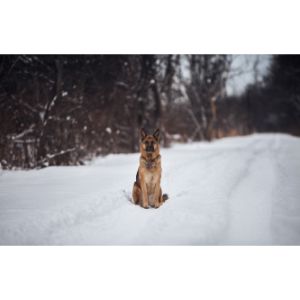
There is no such thing as an equal temperature. Weather factors such as wind, humidity, and rain contribute to the cold feeling worse than on a thermometer.
Other Physical Traits
As well as a low surface-to-volume ratio, fluffy bush tails, and countercurrent heat exchange are other physical traits dogs in cold climates have developed to insulate themselves.
Surface Area
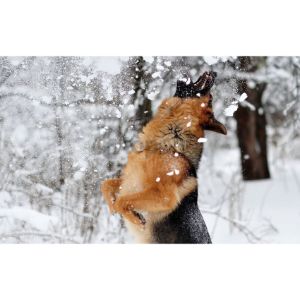
Bergmann’s rule states that species will have an increased body mass as they are exposed to cold or latitude.
This is due to the fact that larger animals tend to have fewer skin cells in proportion to their body weight, which helps them conserve heat better.
The smaller the body, the more skin there is, which allows warmth to escape faster. Due to their lack of insulation, small dogs get cold more quickly than large dogs.
Bushy Tail
The big bushy tails of your German shepherd often curl up snugly against their noses with their feet tucked in during cold days.
Besides being an accessory, bushy tails provide warmth to your dog’s body and paws. Air that dogs breathe out is locked in by their bushy tails, resulting in warm air inhaled.
Countercurrent Heat Exchange System
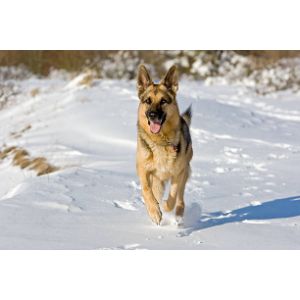
Dogs’ paws possess a countercurrent heat exchange system, according to Dr.Hiroyoshi Ninomiya’s research team. As a result of this system, the dog’s paws maintain a normal temperature through a network of small veins, called venules.
Signs Your German Shepherd Is Cold
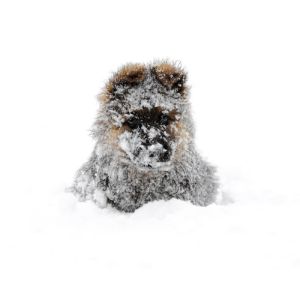
- Shivering
- A howl or bark
- Breathing difficulties
- Creating burrows
- Anxiety
- Whining
- Having difficulty moving or lifting their paws
- Back-hunching
- Tails tucked
- Drowsiness or lethargic behavior
- Gums that are pale or blue
Keep It Leashed
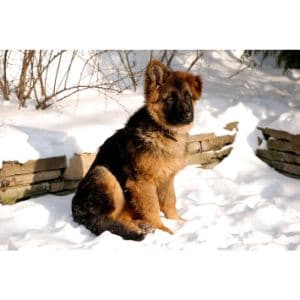
If it is snowing heavily, you should always keep your dog leashed while walking him, especially if he is young or a puppy.
A snowdrift can hide dangerous obstacles as well as be deeper than it appears. Trash and food in cities can be covered by snow, but hunting traps and snares in the countryside can also be covered, as can fallen branches in pits and frozen holes in lakes and ponds.
Use your best judgment when walking off-leash well-trained dogs. Keep an eye on your dog if he runs ahead. Make sure you stick to well-traveled paths. Keep a wide distance from water hazards such as ponds, creeks, and streams during fair weather.
Groom Often
In the winter, when German Shepherds need their coats for warmth more than ever, it is especially important to keep their coats brushed and healthy. A weekly brushing will also benefit your German Shepherd’s coat and skin.
A German Shepherd can have a standard coat, a plush coat, or a long coat. During the winter, stock coat dogs will have the easiest time staying dry because of their hard outer coats that repel water.
In spite of their long and plush coats, dogs with long and plush coats can easily get ill or even die if kept cold. Several coats may be suitable for these breeds of dogs, which are discussed in the following section.
Dog Coats
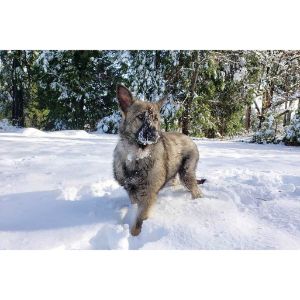
German Shepherds are well adapted to cold weather, even when they are exposed to extreme conditions, as they would be on a typical cold winter night.
Due to their coats being less water resistant than stock coats, plush and coated varieties of German Shepherds are especially in need of dog blankets and shoes.
With adjustable chest and belly straps, these jackets are easy to put on and take off, so they don’t look like “little dog clothes.” They’re great for puppies, as well as older and larger Shepherds.
As far as dog shoes are concerned, there are no guarantees. If your dog has previously suffered paw injuries or is particularly tolerant, you may want to consider it.
When your dog walks through the snow in the inner city, where salt and other chemicals are likely to be added to the streets and sidewalks, these products can make a huge difference.
Get Vet Checkups
When your dog enters from the outside, check his paws and belly. Since most cities chemically treat their streets, salt will likely adhere to his fur and paw pads.
Using a towel or dog wipe will make handling your dog’s paws and legs more comfortable.
The early onset of winter is also a great time to check your dog’s health and address any pre-existing medical problems.
Even dogs who appear to be in good health can develop health problems such as hip or elbow dysplasia. It may be necessary to provide additional care to these dogs during the winter because they are particularly sensitive to the cold.
Shelter
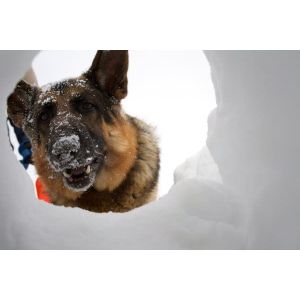
A dog should never be left outside without any shelter. A dog house works great and if you do not have a dog house, make sure your dog can get into another shelter such as a basement or garage.
You can also add doggy doors to your home so your dog can come and go as it pleases and will be able to get back inside your home in the event that it gets too cold outside.
Even if the shelter is available, you should check on your dog often to make sure it is not too cold and seems to be comfortable.
Offer Blankets And Bedding
While this is undoubtedly important, it does not seem to be. Even if you have to buy a few blankets, make sure your German Shepherd has plenty during the winter. Change summer blankets for more insulating plush materials.
Dog blankets should have a fluffy throw blanket in their kennel during the winter, instead of a towel or sheet during the summer.
It’s important to remember that dogs kept indoors get much warmer at night than those kept outside.
If your dog sleeps in a kennel, give it plenty of space to escape blankets and beds. If your dog sleeps with you or in his bed, he will be able to move around and won’t become overheated.
While this breed is clearly tolerant to cold weather, it doesn’t mean they should be left out in the cold for long periods of time.
If your dog prefers to spend time outdoors or if it is an outdoor dog, you should consider offering it blankets or other types of bedding as well as shelter to get out of cold weather.
If your dog appears to be cold, you should take the proper steps to bring it inside and warm it up slowly and safely.
If you are not able to get your dog warm after it has been outside and exposed to cold weather, you will want to contact a veterinarian as quickly as possible.
Your dog may need medication, a heating blanket, and IV fluids to help it overcome the exposure to the cold. Never leave your dog outside in the cold unattended or for long periods of time.
You will also like:
- Golden Retriever And German Shepherd Mix
- Are German Shepherds Easy To Train?
- How Big Are Blue Bay Shepherds?
For more information about the German Shepherd Breed, check out the video down below:

